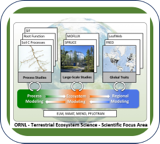The Missouri Ozarks AmeriFlux (MOFLUX) site was established in 2004 at the University of Missouri’s Baskett Forest. The MOFLUX tower is 105 feet tall and equipped to measure the “breathing of the forest” using the eddy covariance technique. This involves measuring wind velocities, gas concentrations, and temperature to determine how eddies (whirls of air) move gases and heat – and how much is exchanging between the forest and atmosphere. A comprehensive suite of other biological measurements is maintained to enable understanding of forest functioning from roots-to-shoots, and leaf-to-landscape. Science at MOFLUX aims to enhance scientific understanding and prediction of:
- Plant function and responses to environmental conditions,
- How extreme events and droughts impact forests, and
- Forest changes over time.

